Research on the Performance Evaluation of Urban Innovation Spaces: A Case Study in Harbin
Abstract
1. Introduction
2. Materials and Methods
2.1. Data Sources
2.2. Research Methods
2.2.1. Entropy Method
2.2.2. Kernel Density Estimation Method
2.2.3. Entropy-Weighted TOPSIS Method
- (1)
- For m objects to be evaluated, each evaluated object has n evaluation indicators, and the decision matrix X is constructed:
- (2)
- Normalize the decision matrix:
- (3)
- Calculate information entropy Hj:where
- (4)
- Define the weight wj of indicator j:
- (1)
- Construct the weighted judgment matrix R:
- (2)
- Determine the positive ideal solution Rj+ and negative ideal solution Rj−:
- (3)
- Calculate the Euclidean distance of each object to the positive ideal solution Di+ and the negative ideal solution Di−:
- (4)
- Calculate the relative closeness to the ideal solution Ti, and the score of object i, Scorei:where the closer Ti is to 1, the better the performance of the evaluation object; the larger the Scorei value, the higher the innovation performance score of the grid.
2.2.4. DEMATEL Method
- (1)
- Establish an evaluation scale. Each expert’s cognition of the degree of influence of the guideline was evaluated by comparing the indicators with each other, and evaluation scales 0, 1, 2, and 4 were used as the measurement criteria, representing relationships of “no influence”, “low influence”, “medium influence”, and “strong influence” in the sequence.
- (2)
- Construct the direct-influence matrix A. According to the opinions of all experts, an initial matrix A of order n × n was obtained by comparing the degree of influence among the indicators:where aij represents the degree of influence of indicator i on indicator j, H represents the total number of experts, k represents the Kth expert, and xk represents the matrix obtained by scoring the Kth expert.
- (3)
- Calculate the normalized direct-influence matrix X:where the sum of each column of X is less than 1.
- (4)
- Calculate the total-influence matrix T:where I is denoted as an identity matrix.
- (5)
- Calculate the sum of rows D and the sum of columns C, which represent the degree of influence of the indicators on other indicators and by other indicators, respectively. Then, calculate the prominence M and relation R:
2.2.5. Summary of Research Methods
3. Results
3.1. Performance Evaluation Results of Five Types of Indicators
3.1.1. Evaluation of Core Elements of Innovation
3.1.2. Evaluation of Entrepreneurship Support Institutions
3.1.3. Evaluation of Service Facilities
3.1.4. Evaluation of External Environment
3.1.5. Evaluation of Diversities
3.2. Performance Evaluation Results of Innovation Spaces
4. Discussion
4.1. Correlation Between Various Indicators
4.1.1. Indicators of Core Elements of Innovation
4.1.2. Indicators of Entrepreneurship Support Institutions
4.1.3. Indicators of Service Facilities
4.1.4. Indicators of External Environment
4.1.5. Indicators of Diversities
4.2. Comparative Analysis of the Indicator System
5. Conclusions
Author Contributions
Funding
Data Availability Statement
Acknowledgments
Conflicts of Interest
References
- Xu, C.; Du, Y.; Qi, L.; Li, R.; Yang, Z. Assessing the Potential for Developing Innovation Districts at the City Scale by Adapting a New Sustainable Entrepreneurial Ecosystems Method. Buildings 2023, 13, 2572. [Google Scholar] [CrossRef]
- Fritsch, M. The theory of economic development: An inquiry into profits, capital, credit, interest, and the business cycle. Reg. Stud. 2017, 51, 654–655. [Google Scholar] [CrossRef]
- Solow, R. A contribution to the theory of economic growth. Q. J. Econ. 1956, 70, 65–94. [Google Scholar] [CrossRef]
- North, D. Institutional change: A framework of analysis. In Social Rules; Routledge: London, UK, 2018; pp. 189–201. [Google Scholar]
- Perroux, F. Note sur la notion de “pôle de croissance”. Économie Appliquée 1955, 8, 307–320. [Google Scholar] [CrossRef]
- Cooke, P. Regional innovation systems: Competitive regulation in the new Europe. Geoforum 1992, 23, 365–382. [Google Scholar] [CrossRef]
- Holmes, J. The Spatial Economy: Cities, Regions, and International Trade; MIT Press: Cambridge, MA, USA, 2000; pp. 491–493. [Google Scholar]
- Landry, C. The Creative City: A Toolkit for Urban Innovators; Earthscan Publication Ltd.: London, UK, 2000. [Google Scholar]
- Katz, B.; Wagner, J. The rise of urban innovation districts. Harv. Bus. Rev. 2014. [Google Scholar]
- Tang, S.; Zhang, J. Review on Progress and Prospect of Urban Innovation Space and Its Planning Practice. Shanghai Urban Plan. Rev. 2022, 87–93. (In Chinese) [Google Scholar] [CrossRef]
- Huggins, R. The evolution of knowledge clusters: Progress and policy. Econ. Dev. Q. 2008, 22, 277–289. [Google Scholar] [CrossRef]
- Esmaeilpoorarabi, N.; Yigitcanlar, T.; Guaralda, M.; Kamruzzaman, M. Does place quality matter for innovation districts? Determining the essential place characteristics from Brisbane’s knowledge precincts. Land Use Policy 2018, 79, 734–747. [Google Scholar] [CrossRef]
- Pancholi, S.; Yigitcanlar, T.; Guaralda, M. Place making for innovation and knowledge-intensive activities:the Australian experience. Technol. Forecast. Soc. Change 2019, 146, 616–625. [Google Scholar] [CrossRef]
- Jones, A. Regenerating urban waterfronts—Creating better futures—From commercial and leisure market places to cultural quarters and innovation districts. Plan. Pract. Res. 2017, 32, 333–344. [Google Scholar] [CrossRef]
- Pancholi, S.; Yigitcanlar, T.; Guaralda, M. Urban knowledge and innovation spaces: Concepts, conditions, and contexts. Asia Pac. J. Innov. Entrep. 2014, 8, 15–38. [Google Scholar]
- Li, X.; Chen, K. Evaluation on Regional Scientific and Technological Innovation Capacity Based on Principal Component Analysis. In International Conference on Logistics Engineering, Management and Computer Science (LEMCS 2015); Atlantis Press: Dordrecht, The Netherlands, 2015; pp. 1582–1587. [Google Scholar]
- Burke, J.; Gras Alomà, R.; Yu, F. Multiplying Effects of Urban Innovation Districts. Geospatial Analysis Framework for Evaluating Innovation Performance Within Urban Environments. In Innovating Strategies and Solutions for Urban Performance and Regeneration; Springer International Publishing: Cham, Switzerland, 2022; pp. 191–207. [Google Scholar]
- Tretyakova, E.; Noskov, A. Innovation performance of Russia’ s northwestern regions: A comparative evaluation. Balt. Reg. 2021, 13, 4–22. [Google Scholar] [CrossRef]
- Rodrigues, M.; Franco, M. Taxonomy of Holistic Performance of Current Creative Cities: Empirical Study. J. Urban Plan. Dev. 2020, 146, 04019030. [Google Scholar] [CrossRef]
- Forsyth, A. Alternative forms of the high-technology district: Corridors, clumps, cores, campuses, subdivisions, and sites. Environ. Plan. C Gov. Policy 2014, 32, 809–823. [Google Scholar] [CrossRef]
- Esmaeilpoorarabi, N.; Yigitcanlar, T.; Guaralda, M.; Kamruzzaman, M. Evaluating place quality in innovation districts: A Delphic hierarchy process approach. Land Use Policy 2018, 76, 471–486. [Google Scholar] [CrossRef]
- Esmaeilpoorarabi, N.; Yigitcanlar, T.; Guaralda, M. Place quality in innovation clusters: An empirical analysis of global best practices from Singapore, Helsinki, New York, and Sydney. Cities 2018, 74, 156–168. [Google Scholar] [CrossRef]
- Yigitcanlar, T.; Adu-McVie, R.; Erol, I. How can contemporary innovation districts be classified? A systematic review of the literature. Land Use Policy 2020, 95, 104595. [Google Scholar] [CrossRef]
- Adu-McVie, R.; Yigitcanlar, T.; Erol, I.; Xia, B. Classifying innovation districts: Delphi validation of a multidimensional framework. Land Use Policy 2021, 111, 105779. [Google Scholar] [CrossRef]
- Adu McVie, R.; Yigitcanlar, T.; Erol, I.; Xia, B. How can innovation district performance be assessed? Insights from South East Queensland, Australia. J. Place Manag. Dev. 2023, 16, 183–247. [Google Scholar] [CrossRef]
- Rapetti, C.; Pique, J.; Pareja-Eastaway, M.; Grimaldi, D. Measuring the development of innovations districts through indicators: 22@Barcelona Case. J. Evol. Stud. Bus. 2022, 7, 6–39. [Google Scholar] [CrossRef]
- Rapetti, C.; Pique, J.; Berbegal-Mirabent, J.; Figlioli, A. Performance indicators for the evolution of areas of innovation: Porto digital case. J. Evol. Stud. Bus. 2022, 7, 219–267. [Google Scholar] [CrossRef]
- Rapetti, C.; Pique, J.M.; Etzkowitz, H.; Miralles, F.; Duran, J. Development of Innovation Districts: A Performance Assessment. Triple Helix 2023, 10, 77–124. [Google Scholar] [CrossRef]
- Etzkowitz, H.; Leydesdorff, L. The dynamics of innovation: From National Systems and “Mode 2” to a Triple Helix of university-industry-government relations. Res. Policy 2000, 29, 109–123. [Google Scholar] [CrossRef]
- Tan, Y.; Qian, Q.; Chen, X. Innovation District Space and Element Identification Framework: Empirical Research from Shenzhen, China. J. Urban Plan. Dev. 2023, 149, 05022041. [Google Scholar]
- Musiaka, Ł.; Nalej, M. Application of GIS Tools in the Measurement Analysis of Urban Spatial Layouts Using the Square Grid Method. ISPRS Int. J. Geo-Inf. 2021, 10, 558. [Google Scholar] [CrossRef]
- Zielstra, D.; Zipf, A. A comparative study of proprietary geodata and volunteered geographic information for Germany. In Proceedings of the 13th AGILE International Conference on Geographic Information Science, Guimarães, Portugal, 11–14 May 2010; pp. 1–15. [Google Scholar]
- Neis, P.; Zielstra, D.; Zipf, A. The street network evolution of crowdsourced maps: OpenStreetMap in Germany 2007–2011. Future Internet 2011, 4, 1–21. [Google Scholar] [CrossRef]
- Corcoran, P.; Mooney, P.; Bertolotto, M. Analysing the growth of OpenStreetMap networks. Spat. Stat. 2013, 3, 21–32. [Google Scholar] [CrossRef]
- Al-Bakri, M. Ten years of OpenStreetMap project: Have we addressed data quality appropriately?—Review Paper. J. Eng. 2015, 21, 158–175. [Google Scholar] [CrossRef]
- Available online: www.openstreetmap.org (accessed on 10 December 2022).
- Li, Y. The Measurement and Evolution Characteristics of Spatial Structure of Urban Innovation: The Perspective of Innovation Activity Distribution. Urban Plan. Forum 2022, 1, 74–80. (In Chinese) [Google Scholar]
- Guan, M.; Sun, S. Agglomeration characteristics and influencing factors of urban innovation space: A case study of Nanjing main city. City Plan. Rev. 2023, 47, 21–31. (In Chinese) [Google Scholar]
- Chen, J.; Huang, H.; Chen, X. The Evolution of Urban Innovation Spatial Structure on the Basis of Spatial Grids: A Case Study of Guangzhou. Mod. Urban Res. 2018, 84–90. (In Chinese) [Google Scholar] [CrossRef]
- Na, M.; Bian, B. Research on Planning Path of Innovation Districts Based on Innovation Ecosystem Theory: A Case Study of Hangzhou Future Scitech City. City Plan. Rev. 2022, 46, 7–20+53. [Google Scholar]
- Mulas, V.; Minges, M.; Applebaum, H. Boosting tech innovation: Ecosystems in cities: A framework for growth and sustainability of urban tech innovation ecosystems. Innov. Technol. Gov. Glob. 2016, 11, 98–125. [Google Scholar] [CrossRef]
- Clifton, N. The “creative class” in the UK: An initial analysis. Geogr. Ann. Ser. B Hum. Geogr. 2008, 90, 63–82. [Google Scholar] [CrossRef]
- Shi, X.; Chen, Y.; Xia, M.; Zhang, Y. Effects of the talent war on urban innovation in China: A difference-in-differences analysis. Land 2022, 11, 1485. [Google Scholar] [CrossRef]
- Nagaoka, S.; Motohashi, K.; Goto, A. Patent statistics as an innovation indicator. In Handbook of the Economics of Innovation; North-Holland: Amsterdam, The Netherlands, 2010; Volume 2, pp. 1083–1127. [Google Scholar]
- Ponta, L.; Puliga, G.; Manzini, R. A measure of innovation performance: The Innovation Patent Index. Manag. Decis. 2021, 59, 73–98. [Google Scholar] [CrossRef]
- Available online: https://www.harbin.gov.cn (accessed on 10 September 2023).
- Available online: https://pss-system.cponline.cnipa.gov.cn/conventionalSearch (accessed on 10 June 2024).
- Available online: https://www.gov.cn/zhengce/zhengceku/2022-06/02/content_5693548.htm (accessed on 10 September 2023).
- Available online: https://hlipa.hlj.gov.cn/hlipa/c103155/202306/c00_31645587.shtml (accessed on 10 September 2023).
- Florida, R. Cities and the creative class. City Community 2003, 2, 3–19. [Google Scholar] [CrossRef]
- Wu, S.; Li, B.; Xu, D. Agglomeration Characteristics and Influencing Factors of Urban Innovation Spaces Based on the Distribution Data of High-Tech Enterprises in Harbin. Buildings 2024, 14, 1615. [Google Scholar] [CrossRef]
- Li, L.; Zhang, X. Spatial evolution and critical factors of urban innovation: Evidence from Shanghai, China. Sustainability 2020, 12, 938. [Google Scholar] [CrossRef]
- Jacobs-Crisioni, C.; Rietveld, P.; Koomen, E.; Tranos, E. Evaluating the impact of land-use density and mix on spatiotemporal urban activity patterns: An exploratory study using mobile phone data. Environ. Plan. A 2014, 46, 2769–2785. [Google Scholar] [CrossRef]
- Chen, Z.; Dong, B.; Pei, Q.; Zhang, Z. The impacts of urban vitality and urban density on innovation: Evidence from China’s Greater Bay Area. Habitat Int. 2022, 119, 102490. [Google Scholar] [CrossRef]
- Liu, B.; Zheng, S.; Zhang, L.; Liu, J.; Fu, T.; Hao, R.; Yin, M. Identification and Analysis of Potential Open-Sharing Subjects of Unit-Affiliated Green Spaces in Shanghai Based on POI Data. Land 2023, 12, 2162. [Google Scholar] [CrossRef]
- Psyllidis, A.; Gao, S.; Hu, Y.; Kim, E.K.; McKenzie, G.; Purves, R.; Yuan, M.; Andris, C. Points of Interest (POI): A commentary on the state of the art, challenges, and prospects for the future. Comput. Urban Sci. 2022, 2, 20. [Google Scholar] [CrossRef]
- Yao, Y.; Zhu, Q.; Guo, Z.; Huang, W.; Zhang, Y.; Yan, X.; Dong, A.; Jiang, Z.; Liu, H.; Guan, Q. Unsupervised land-use change detection using multi-temporal POI embedding. Int. J. Geogr. Inf. Sci. 2023, 37, 2392–2415. [Google Scholar] [CrossRef]
- Li, X.; Bu, R.; Chang, Y.; Hu, Y.; Wen, Q.; Wang, X.; Xu, C.; Li, Y.; He, H. The response of landscape metrics against pattern scenarios. Acta Ecol. Sin. 2004, 1, 123–134. (In Chinese) [Google Scholar]
- Hwang, C.; Yoon, K. Multiple Attribute Decision Making; Springer: Berlin/Heidelberg, Germany, 1981; p. 36. [Google Scholar]
- Sayareh, J.; Alizmini, H. A hybrid decision-making model for selecting container seaport in the Persian Gulf. Asian J. Shipp. Logist. 2014, 30, 75–95. [Google Scholar] [CrossRef]
- Shen, L.; Huang, Z.; Wong, S.W.; Liao, S.; Lou, Y. A holistic evaluation of smart city performance in the context of China. J. Clean. Prod. 2018, 200, 667–679. [Google Scholar] [CrossRef]
- Chen, P. Effects of the entropy weight on TOPSIS. Expert Syst. Appl. 2021, 168, 114186. [Google Scholar] [CrossRef]
- Si, S.; You, X.; Liu, H.; Zhang, P. DEMATEL technique: A systematic review of the state-of-the-art literature on methodologies and applications. Math. Probl. Eng. 2018, 1, 3696457. [Google Scholar] [CrossRef]
- Kumar, A.; Dash, M. Using DEMATEL to construct influential network relation map of consumer decision-making in e-marketplace. Int. J. Bus. Inf. Syst. 2016, 21, 48–72. [Google Scholar] [CrossRef]
- Wu, Y.; Yang, Y.; Xu, W.; Chen, Q. The influence of innovation resources in higher education institutions on the development of Sci-tech parks’ enterprises in the urban innovative districts at the stage of urbanization transformation. Land 2020, 9, 396. [Google Scholar] [CrossRef]
- Ferreira, J.; Ferreira, C.; Bos, E. Spaces of consumption, connection, and community: Exploring the role of the coffee shop in urban lives. Geoforum 2021, 119, 21–29. [Google Scholar] [CrossRef]
- Oldenburg, R. The Great Good Place: Cafes, Coffee Shops, Bookstores, Bars, Hair Salons, and Other Hangouts at the Heart of a Community; Da Capo Press: Cambridge, MA, USA, 1999. [Google Scholar]
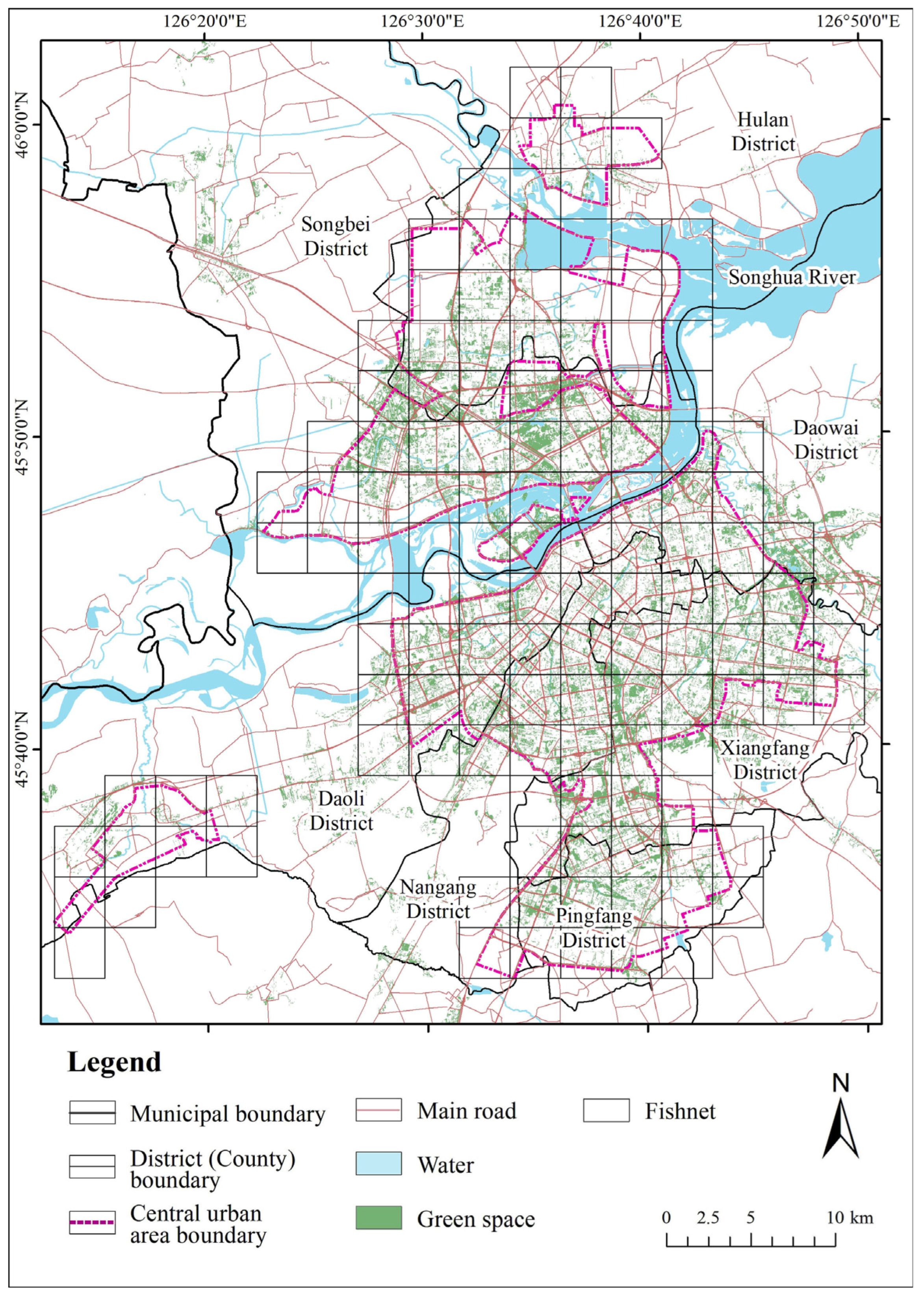
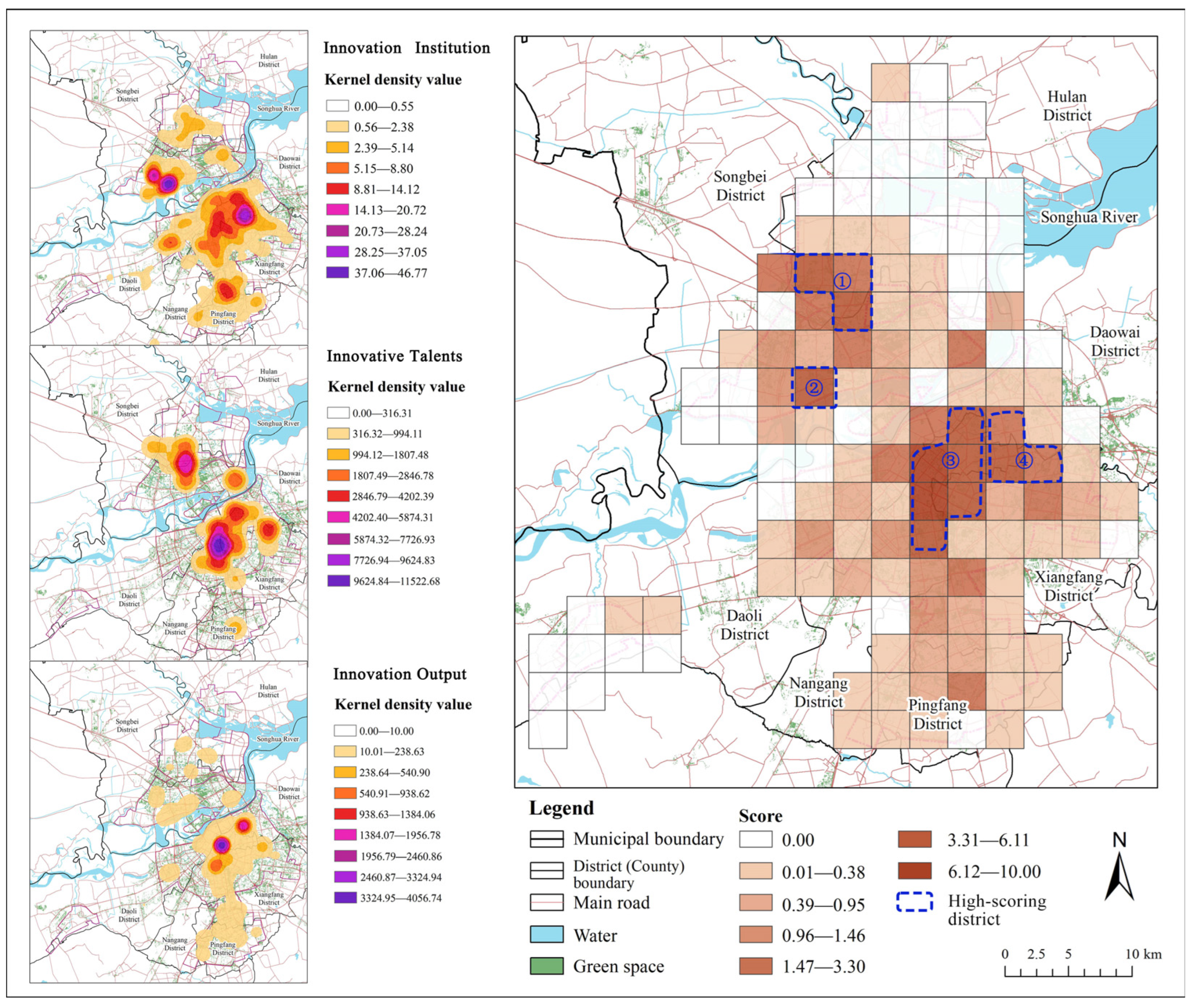
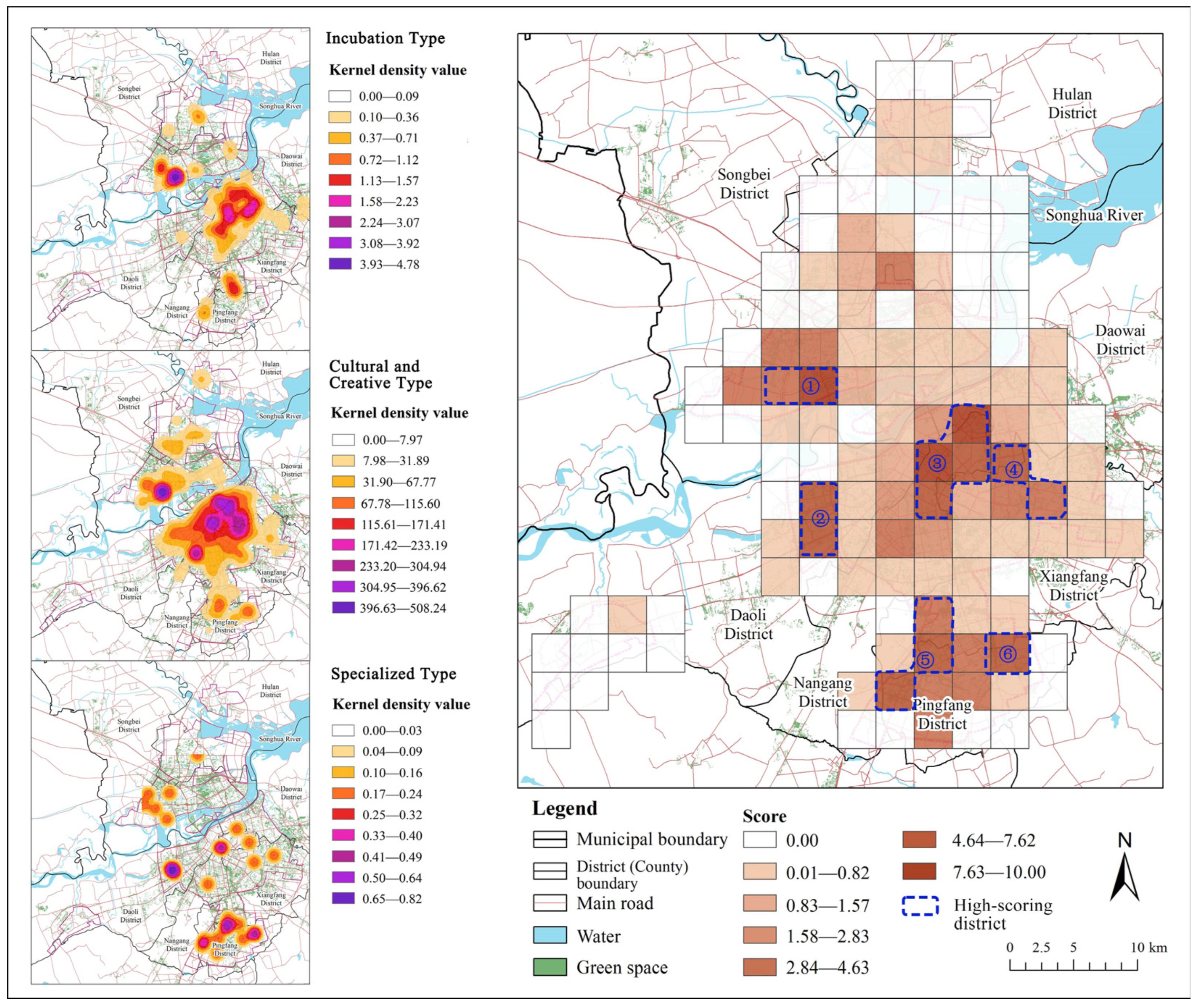
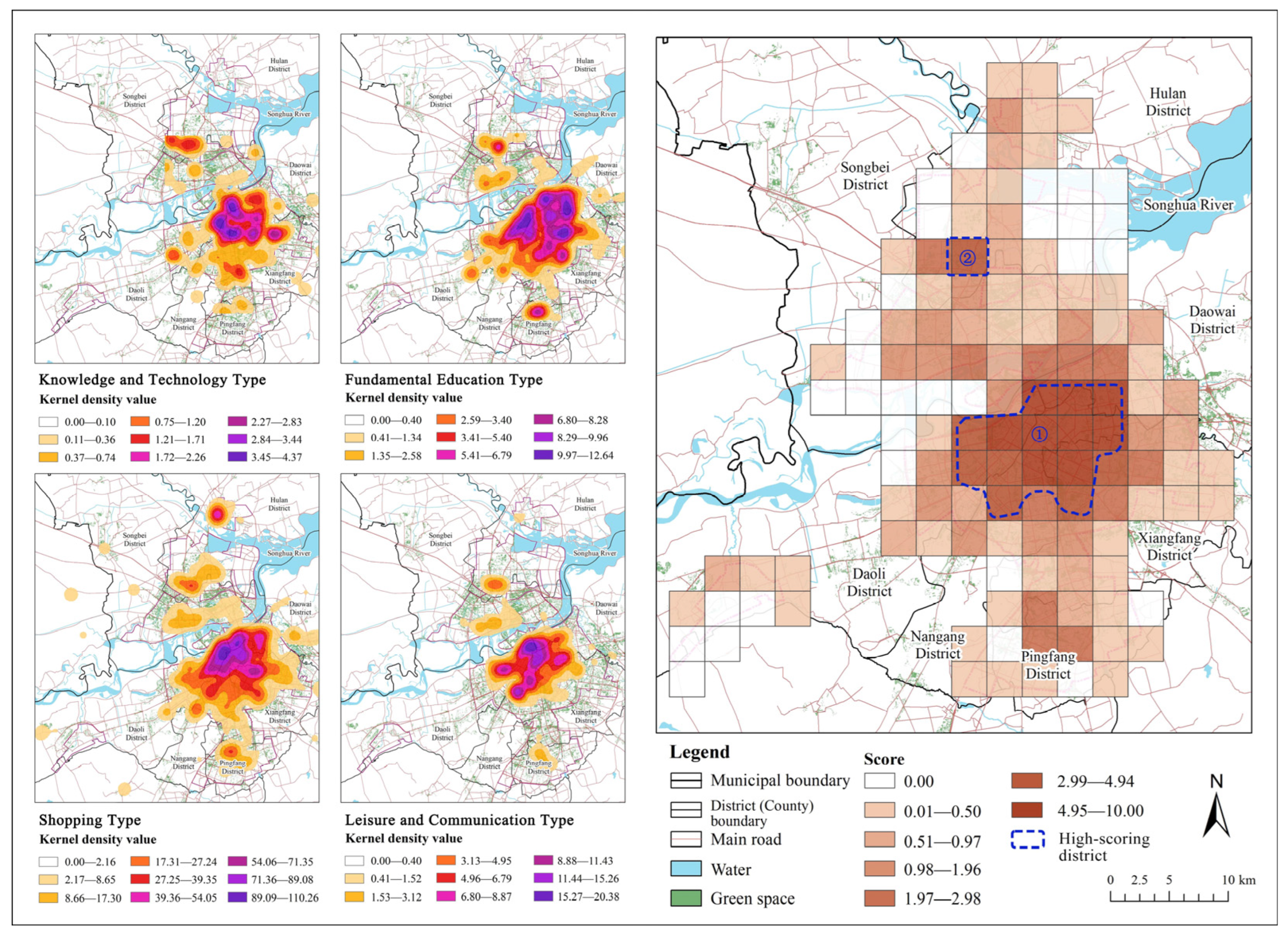


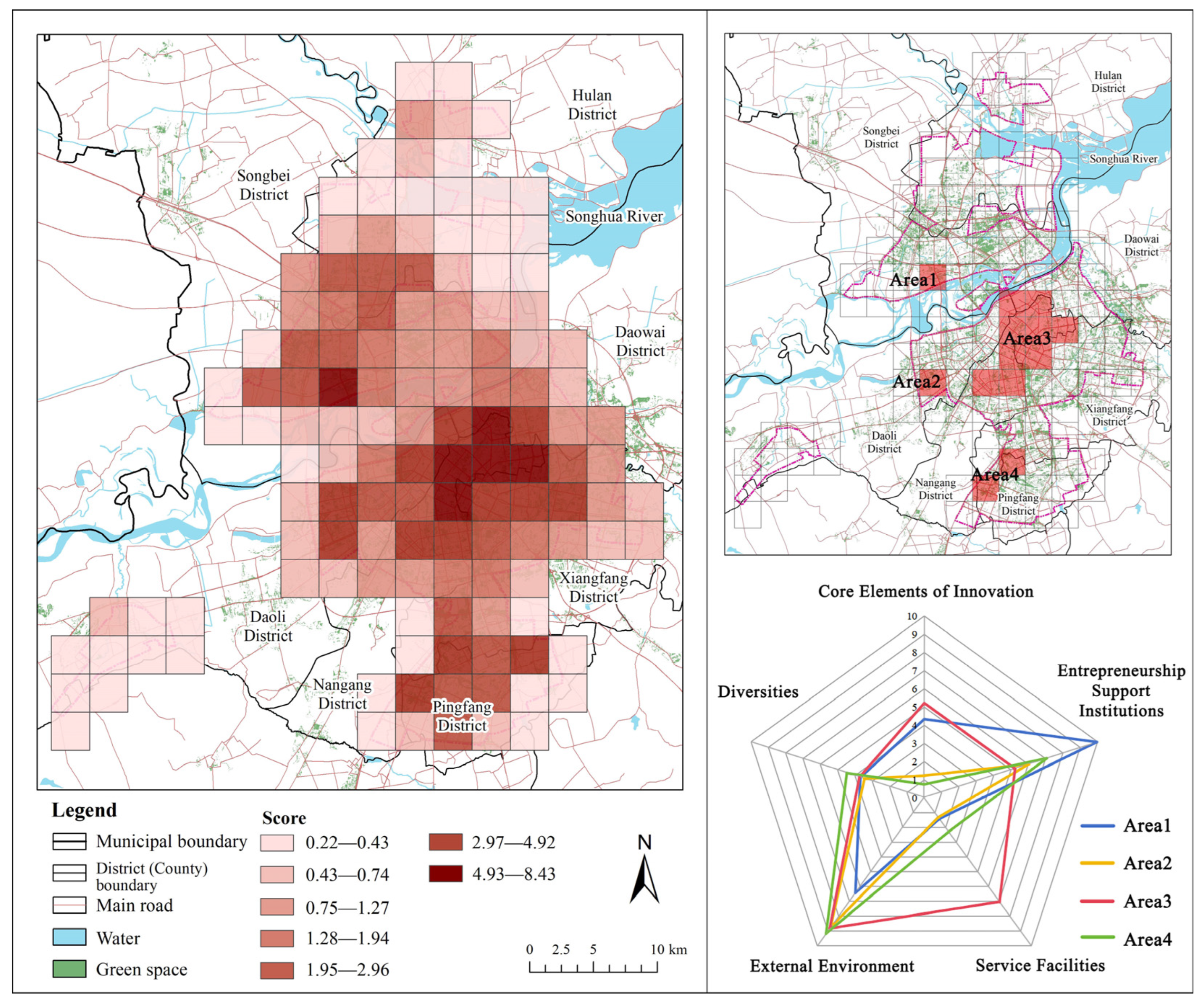
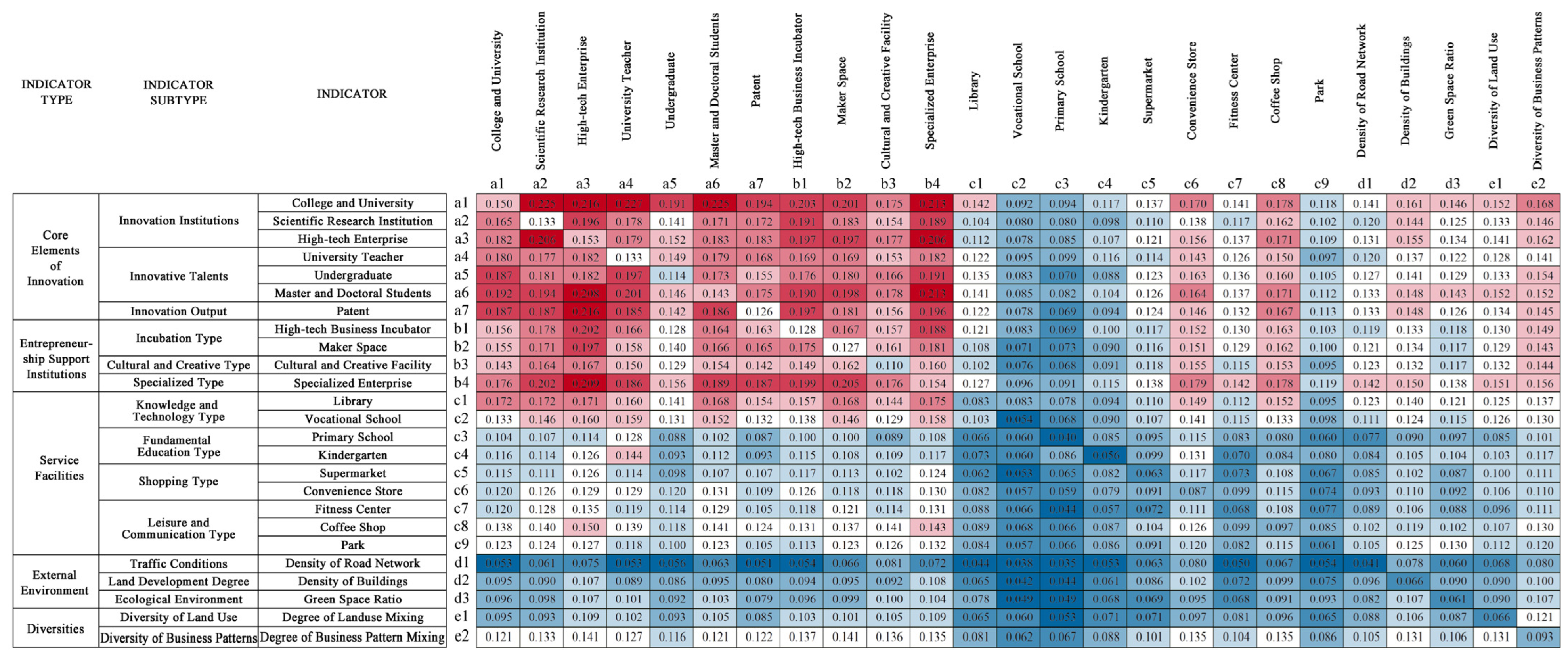
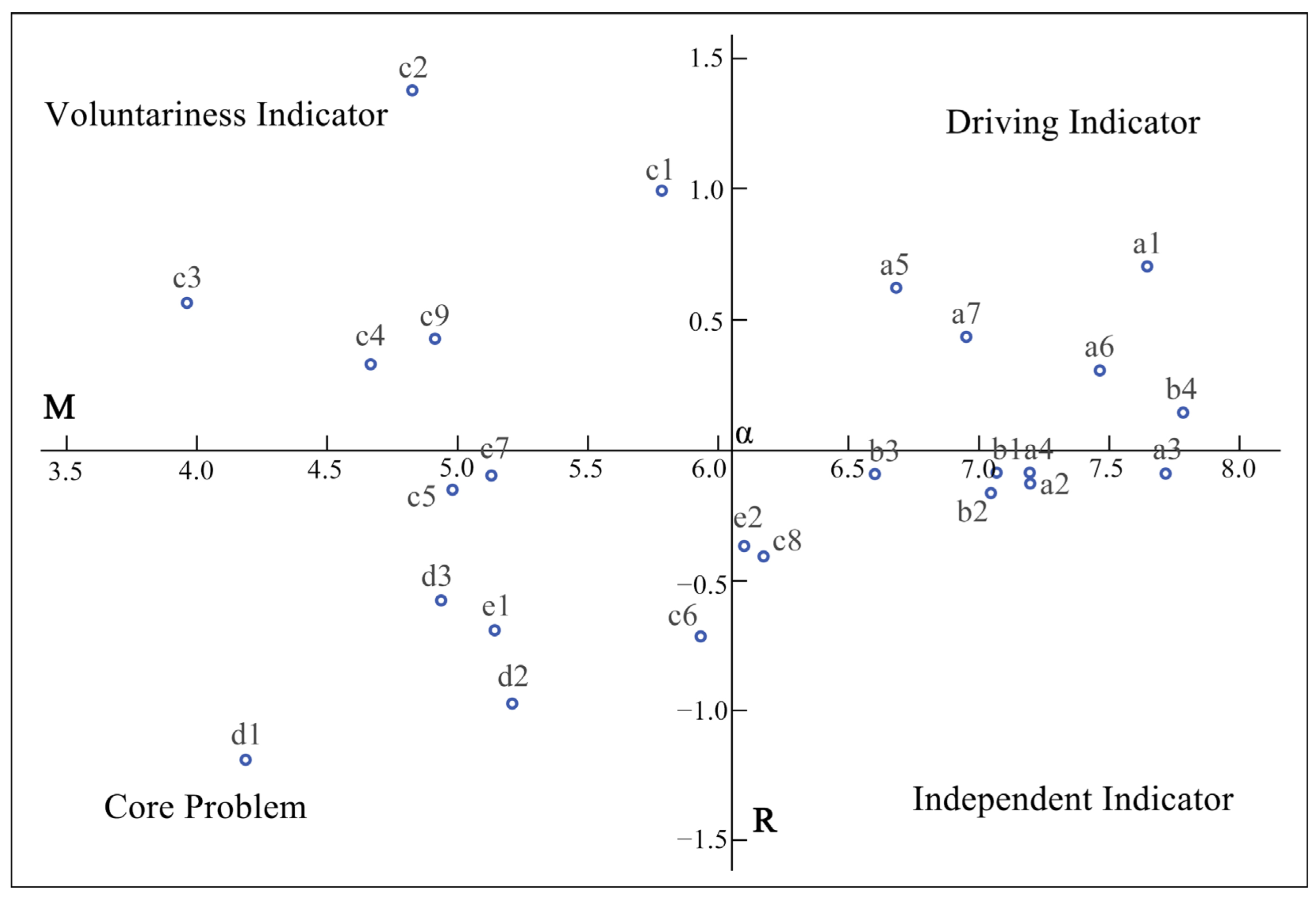
| Type | Subtype | Specific Indicator | Unit | Data Source |
|---|---|---|---|---|
| (A) Core elements of innovation | (A1) Innovation institutions | (a1) Density of colleges and universities | per km2 | Websites of relevant universities |
| (a2) Density of scientific research institutions | per km2 | Official government website | ||
| (a3) Density of high-tech enterprises | per km2 | |||
| (A2) Innovation talents | (a4) Density of university teachers | per km2 | Websites of relevant colleges and universities | |
| (a5) Density of undergraduates | per km2 | |||
| (a6) Density of master’s and doctoral students | per km2 | |||
| (A3) Innovation output | (a7) Density of patents | per km2 | Patent website | |
| (B) Entrepreneurship support institutions | (B1) Incubation type | (b1) Density of high-tech business incubators | per km2 | Official government website |
| (b2) Density of maker spaces | per km2 | |||
| (B2) Cultural and creative type | (b3) Density of cultural and creative facilities | per km2 | ||
| (B3) Specialized type | (b4) Density of specialized enterprises | per km2 | ||
| (C) Service facilities | (C1) Knowledge and technology type | (c1) Density of libraries | per km2 | Gaode Map API |
| (c2) Density of vocational schools | per km2 | |||
| (C2) Fundamental education type | (c3) Density of primary schools | per km2 | ||
| (c4) Density of kindergartens | per km2 | |||
| (C3) Shopping type | (c5) Density of supermarkets | per km2 | ||
| (c6) Density of convenience stores | per km2 | |||
| (C4) Leisure and communication type | (c7) Density of fitness centers | per km2 | ||
| (c8) Density of coffee shops | per km2 | |||
| (c9) Density of parks | per km2 | |||
| (D) External Environment | (D1) Traffic conditions | (d1) Density of road network | km per km2 | OSM dataset |
| (D2) Land development degree | (d2) Density of building | % | ||
| (D3) Ecological environment | (d3) Green space ratio | % | ||
| (E) Diversities | (E1) Diversity of land use | (e1) Degree of land-use mixing | # | Official government website |
| (E2) Diversity of business patterns | (e2) Degree of business pattern mixing | # | Gaode Map API |
| POI Data Type | Number (Entries) | POI Data Type | Number (Entries) |
|---|---|---|---|
| Catering services | 33,405 | Tourist attractions | 813 |
| Companies | 14,374 | Automobile services | 9466 |
| Shopping and consumption | 44,921 | Commercial residences | 4423 |
| Traffic facilities | 9487 | Life services | 24,749 |
| Financing institutions | 2473 | Entertainment | 2038 |
| Hotel accommodations | 6494 | Medical care | 9532 |
| Science, education, and cultural services | 8193 | Exercise and fitness | 1858 |
| Expert | Major | Affiliation | Highest Degree | Experience (Years) | Mode of Investigation |
|---|---|---|---|---|---|
| Expert 1 | Public policy | Harbin Municipal government | PhD | 39 | Offline |
| Expert 2 | Geographic information | Harbin Institute of Technology | PhD | 29 | Offline |
| Expert 3 | Urban planning | Beijing Institute of Architectural Design | PhD | 12 | Offline |
| Expert 4 | Urban planning | Xi’an University of Architecture and Technology | PhD | 10 | Offline |
| Expert 5 | Urban planning | Harbin Institute of Technology | Master’s | 10 | Offline |
| Expert 6 | Landscape | Wuhan University | PhD | 16 | Online |
| Expert 7 | Architecture | Chinese Academy of Forestry | PhD | 14 | Offline |
| Expert 8 | Landscape | Urban Planning and Design Institute, Harbin Institute of Technology | Master’s | 23 | Offline |
| Expert 9 | Sociology | Northeast Forestry University | Master’s | 21 | Online |
| Expert 10 | Sociology | Heilongjiang University of Science and Technology | Master’s | 20 | Offline |
| Method Name | Core Objective | Key Input Data | Corresponding to Sections |
|---|---|---|---|
| Entropy method | Measuring the degree of land-use mixing and the degree of business pattern mixing | Land-use data, POI data | Evaluation of diversities |
| Kernel density estimation method | Identifying hotspots of the spatial aggregation of innovation elements | Geographic data of innovation elements | Evaluation of core elements of innovation, entrepreneurship support institutions, and service facilities |
| Entropy-weighted TOPSIS method | Calculating the performance score of innovation spaces’ grid cells | Innovative spaces’ performance evaluation indicator data | Results |
| DEMATEL method | Calculating the interactions between indicators | Expert scoring matrix | Discussion |
| Type | Weight (%) | Subtype | Weight (%) | Specific Indicators | Weight (%) |
|---|---|---|---|---|---|
| (A) Core elements of innovation | 29.78 | (A1) Innovation institutions | 11.59 | (a1) Number of colleges and universities | 4.03 |
| (a2) Number of scientific research institutions | 4.60 | ||||
| (a3) Number of high-tech enterprises | 2.96 | ||||
| (A2) Innovation talents | 14.02 | (a4) Number of university teachers | 4.22 | ||
| (a5) Number of undergraduates | 4.37 | ||||
| (a6) Number of master’s and doctoral students | 5.43 | ||||
| (A3) Innovation output | 4.17 | (a7) Number of patents | 4.17 | ||
| (B) Entrepreneurship support institutions | 33.80 | (B1) Incubation type | 17.10 | (b1) Number of high-tech business incubators | 8.14 |
| (b2) Number of maker spaces | 8.96 | ||||
| (B2) Cultural and creative type | 7.37 | (b3) Number of cultural and creative facilities | 7.37 | ||
| (B3) Specialized type | 9.33 | (b4) Number of specialized enterprises | 9.33 | ||
| (C) Service facilities | 26.62 | (C1) Knowledge and technology type | 5.59 | (c1) Number of libraries | 3.34 |
| (c2) Number of vocational schools | 2.25 | ||||
| (C2) Fundamental education type | 5.30 | (c3) Number of primary schools | 2.35 | ||
| (c4) Number of kindergartens | 2.95 | ||||
| (C3) Shopping type | 6.69 | (c5) Number of supermarkets | 3.64 | ||
| (c6) Number of convenience stores | 3.05 | ||||
| (C4) Leisure and communication type | 9.04 | (c7) Number of fitness centers | 2.60 | ||
| (c8) Number of coffee shops | 3.10 | ||||
| (c9) Number of parks | 3.34 | ||||
| (D) External environment | 7.28 | (D1) Traffic conditions | 2.08 | (d1) Density of road network | 2.08 |
| (D2) Land development degree | 2.38 | (d2) Density of buildings | 2.38 | ||
| (D3) Ecological environment | 2.82 | (d3) Green space ratio | 2.82 | ||
| (E) Diversities | 2.52 | (E1) Diversity of land use | 0.86 | (e1) Degree of land-use mixing | 0.86 |
| (E2) Diversity of business patterns | 1.66 | (e2) Degree of business pattern mixing | 1.66 |
| Type | Subtype | Specific Indicators | D (Influence Degree) | C (Influenced Degree) | M (Centrality) | R (Cause Degree) |
|---|---|---|---|---|---|---|
| (A) Core elements of innovation | (A1) Innovation institutions | (a1) Number of colleges and universities | 4.177 | 3.474 | 7.651 | 0.703 |
| (a2) Number of scientific research institutions | 3.534 | 3.662 | 7.196 | −0.128 | ||
| (a3) Number of high-tech enterprises | 3.813 | 3.906 | 7.719 | −0.093 | ||
| (A2) Innovation talents | (a4) Number of university teachers | 3.553 | 3.642 | 7.195 | −0.089 | |
| (a5) Number of undergraduates | 3.649 | 3.035 | 6.684 | 0.614 | ||
| (a6) Number of master’s and doctoral students | 3.884 | 3.584 | 7.468 | 0.300 | ||
| (A3) Innovation output | (a7) Number of patents | 3.690 | 3.262 | 6.952 | 0.428 | |
| (B) Entrepreneurship support institutions | (B1) Incubation type | (b1) Number of high-tech business incubators | 3.487 | 3.573 | 7.060 | −0.086 |
| (b2) Number of maker spaces | 3.438 | 3.606 | 7.044 | −0.168 | ||
| (B2) Cultural and creative type | (b3) Number of cultural and creative facilities | 3.253 | 3.349 | 6.602 | −0.096 | |
| (B3) Specialized type | (b4) Number of specialized enterprises | 3.961 | 3.821 | 7.782 | 0.140 | |
| (C) Service facilities | (C1) Knowledge and technology type | (c1) Number of libraries | 3.385 | 2.399 | 5.784 | 0.986 |
| (c2) Number of vocational schools | 3.099 | 1.726 | 4.825 | 1.373 | ||
| (C2) Fundamental education type | (c3) Number of primary schools | 2.259 | 1.699 | 3.958 | 0.560 | |
| (c4) Number of kindergartens | 2.499 | 2.173 | 4.672 | 0.326 | ||
| (C3) Shopping type | (c5) Number of supermarkets | 2.411 | 2.567 | 4.978 | −0.156 | |
| (c6) Number of convenience stores | 2.610 | 3.322 | 5.932 | −0.712 | ||
| (C4) Leisure and communication type | (c7) Number of fitness centers | 2.515 | 2.617 | 5.132 | −0.102 | |
| (c8) Number of coffee shops | 2.881 | 3.294 | 6.175 | −0.413 | ||
| (c9) Number of parks | 2.670 | 2.245 | 4.915 | 0.425 | ||
| (D) External environment | (D1) Traffic condition | (d1) Density of road network | 1.497 | 2.690 | 4.187 | −1.193 |
| (D2) Land development degree | (d2) Density of buildings | 2.118 | 3.094 | 5.212 | −0.976 | |
| (D3) Ecological environment | (d3) Green space ratio | 2.181 | 2.756 | 4.937 | −0.575 | |
| (E) Diversities | (E1) Diversity of land use | (e1) Degree of land-use mixing | 2.225 | 2.921 | 5.146 | −0.696 |
| (E2) Diversity of business patterns | (e2) Degree of business pattern mixing | 2.857 | 3.228 | 6.085 | −0.371 |
Disclaimer/Publisher’s Note: The statements, opinions and data contained in all publications are solely those of the individual author(s) and contributor(s) and not of MDPI and/or the editor(s). MDPI and/or the editor(s) disclaim responsibility for any injury to people or property resulting from any ideas, methods, instructions or products referred to in the content. |
© 2025 by the authors. Licensee MDPI, Basel, Switzerland. This article is an open access article distributed under the terms and conditions of the Creative Commons Attribution (CC BY) license (https://creativecommons.org/licenses/by/4.0/).
Share and Cite
Wu, S.; Li, B.; Xu, D. Research on the Performance Evaluation of Urban Innovation Spaces: A Case Study in Harbin. Buildings 2025, 15, 2258. https://doi.org/10.3390/buildings15132258
Wu S, Li B, Xu D. Research on the Performance Evaluation of Urban Innovation Spaces: A Case Study in Harbin. Buildings. 2025; 15(13):2258. https://doi.org/10.3390/buildings15132258
Chicago/Turabian StyleWu, Songtao, Bowen Li, and Daming Xu. 2025. "Research on the Performance Evaluation of Urban Innovation Spaces: A Case Study in Harbin" Buildings 15, no. 13: 2258. https://doi.org/10.3390/buildings15132258
APA StyleWu, S., Li, B., & Xu, D. (2025). Research on the Performance Evaluation of Urban Innovation Spaces: A Case Study in Harbin. Buildings, 15(13), 2258. https://doi.org/10.3390/buildings15132258






